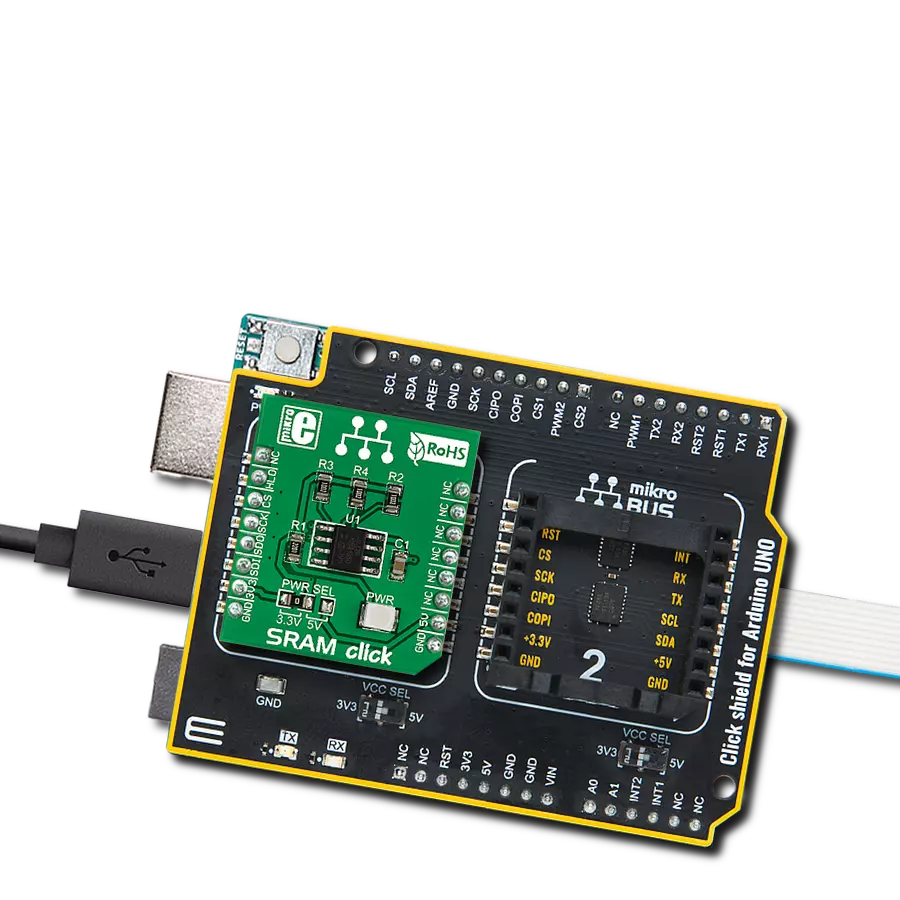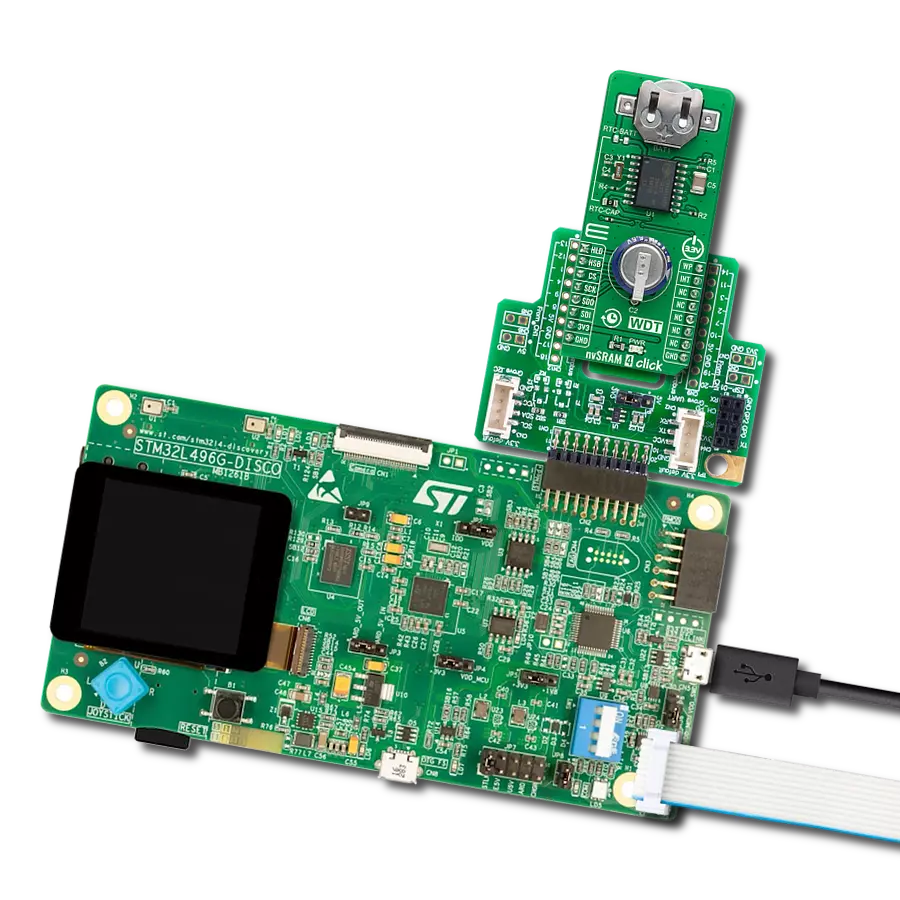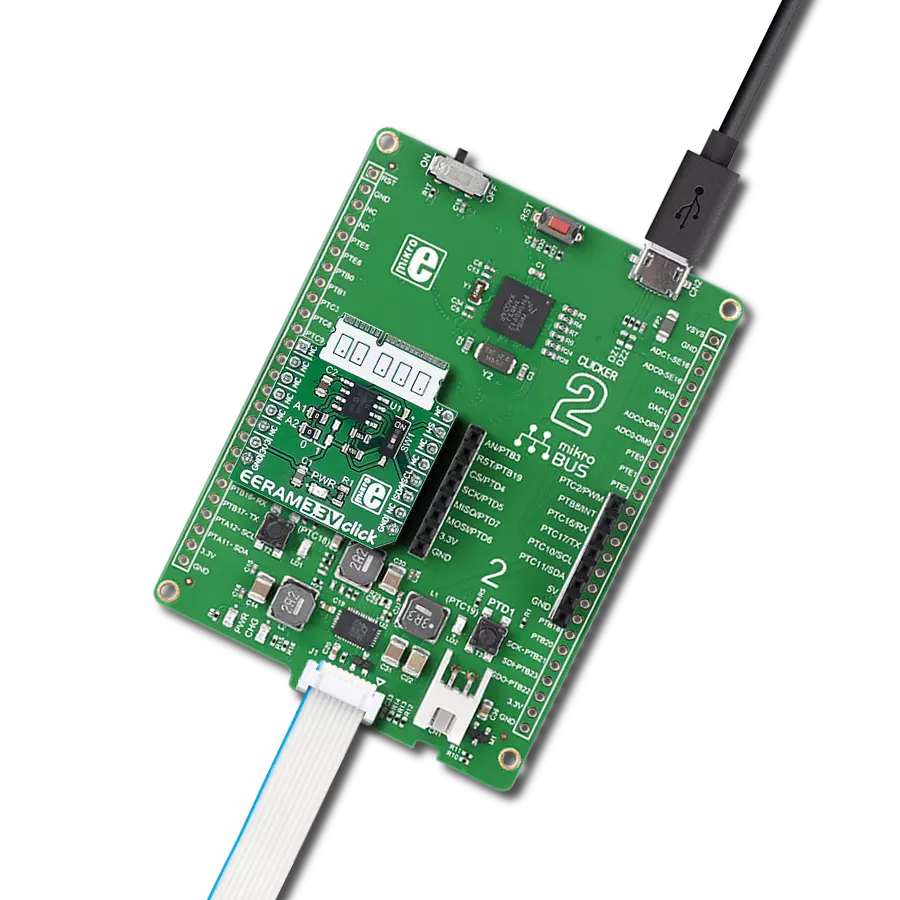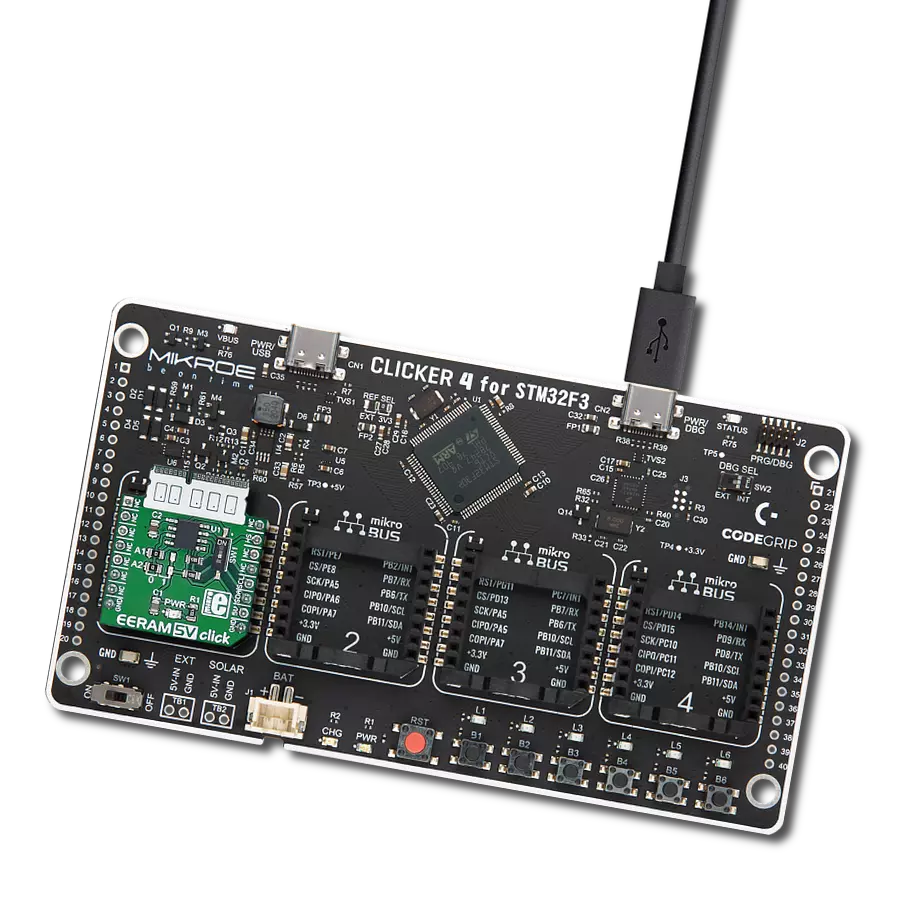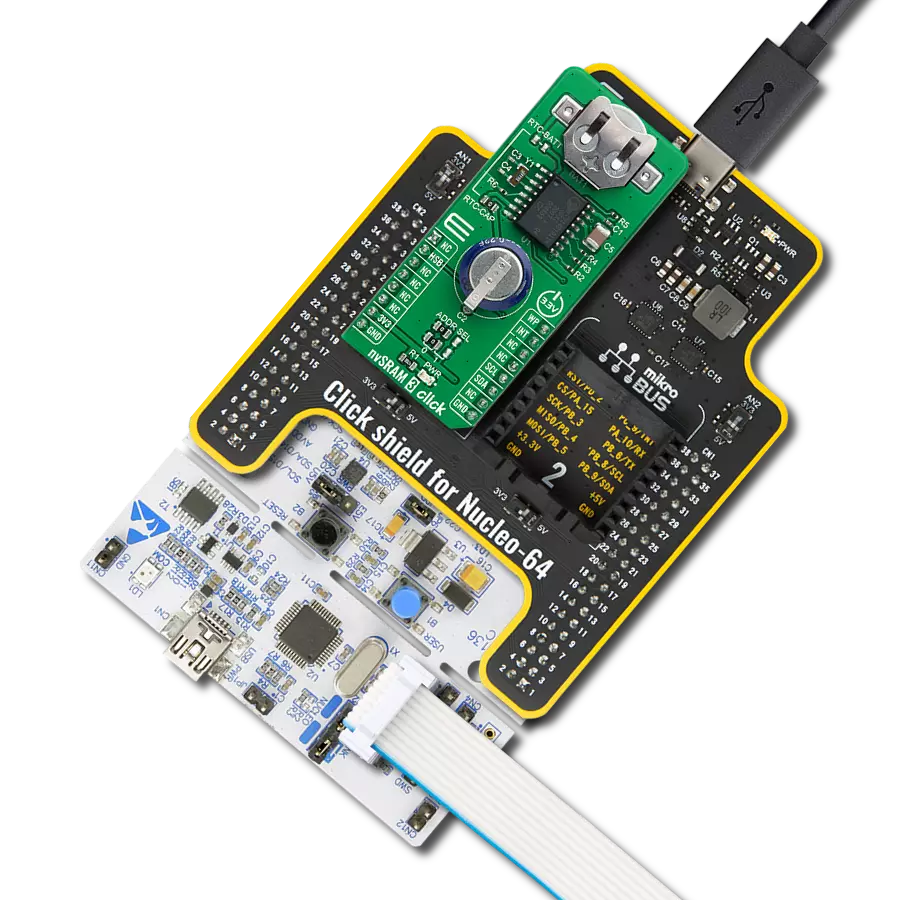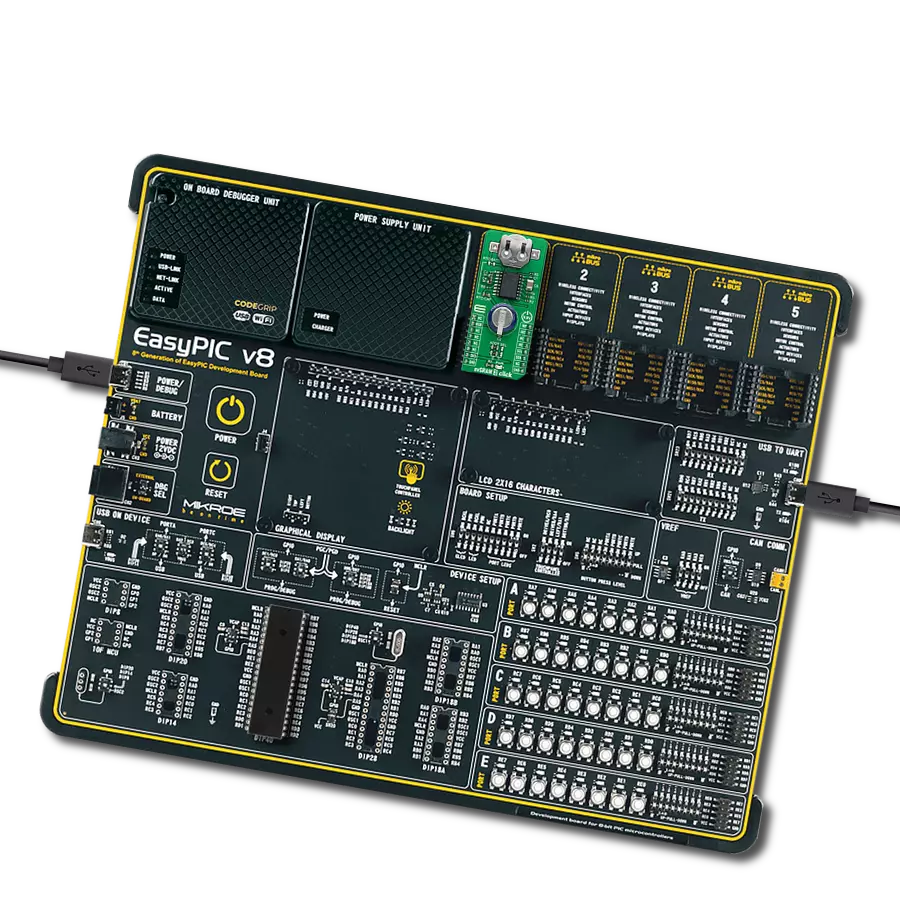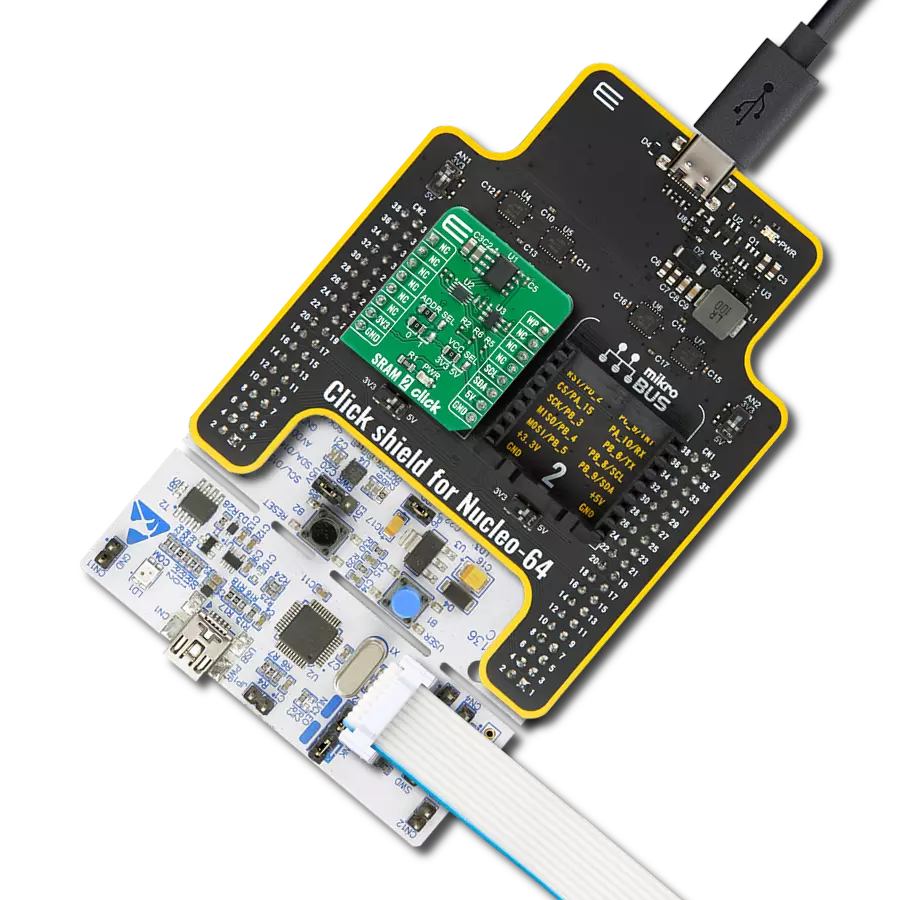Experience the perfect harmony of performance and peace of mind with nvSRAM, the ultimate memory solution for critical applications
A
A
Hardware Overview
How does it work?
nvSRAM 4 Click is based on the CY14B101PA, a 1-Mbit nvSRAM memory organized as 128K words of 8 bits each, with a fully-featured real-time clock from Infineon. The nvSRAM specifies one million endurance cycles for nonvolatile cells with data retention of a minimum of 20 years. All the reads and writes to nvSRAM happen to the SRAM, which gives nvSRAM the unique capability to handle infinite writes to the memory. The benefit of nvSRAM over serial EEPROMs is that all reads and writes to nvSRAM are performed at the SPI speed with zero cycle delay, which means, therefore, no wait time is required after any of the memory accesses. In addition to the CY14B101PA, this Click board™ is equipped with the button cell battery holder compatible with the 3000TR battery holder, suitable for 12mm Coin Cell batteries. When the primary power fails and drops below 2.65V, this Click board™ switches to the backup power supply by placing a jumper labeled as RTC-BATT. By utilizing an automatic backup, the CY14B101PA uses an external battery power source when there is no power supply on its main power terminals, allowing for uninterrupted operation. nvSRAM 4
Click communicates with MCU using a standard SPI interface with clock frequency up to 40MHz, zero cycle delay read, and write cycles. It also supports the two most common modes, SPI Mode 0 and 3, and 104 MHz SPI access speed with special instructions for the read operation. The CY14B101PA uses the standard SPI opcodes for memory access. In addition to the general SPI instructions for reading and writing, it provides four special instructions: STORE, RECALL, AutoStore Disable (ASDISB), and AutoStore Enable (ASENB). The STORE operation of the CY14B101PA can be controlled and acknowledged via the HSB pin, routed on the RST pin of the mikroBUS™ socket. If no STORE/RECALL is in progress, this pin can request a hardware STORE cycle. When the HSB pin is driven LOW, the CY14B101PA initiates a STORE operation conditionally. Also, this Click board™ can use the AutoStore feature of the SRAM data in nonvolatile cells when the power goes down, providing power-down data security by placing a jumper labeled as RTC-CAP. An additional feature of this Click board™ represents the configurable Write Protection function labeled
as WP routed on the PWM pin of the mikroBUS™ socket. The WP pin protects the entire memory and all registers from write operations and must be held high to inhibit all the write operations. When this pin is high, all memory and register writes are prohibited, and the address counter is not incremented. Besides, the nvSRAM 4 Click also has additional HOLD and Interrupt pins, routed to the AN and INT pins of the mikroBUS™ socket labeled as HLD and INT. The HLD pin is used to pause the serial communication without stopping the operation of the write status register, programming, or erasing in progress. On the other hand, an INT pin can be used in several ways, such as interrupt output, calibration, or a square wave, programmable to respond to the clock alarm, the watchdog timer, and the power monitor. This Click board™ can be operated only with a 3.3V logic voltage level. The board must perform appropriate logic voltage level conversion before using MCUs with different logic levels. Also, it comes equipped with a library containing functions and an example code that can be used as a reference for further development.
Features overview
Development board
PIC18F57Q43 Curiosity Nano evaluation kit is a cutting-edge hardware platform designed to evaluate microcontrollers within the PIC18-Q43 family. Central to its design is the inclusion of the powerful PIC18F57Q43 microcontroller (MCU), offering advanced functionalities and robust performance. Key features of this evaluation kit include a yellow user LED and a responsive
mechanical user switch, providing seamless interaction and testing. The provision for a 32.768kHz crystal footprint ensures precision timing capabilities. With an onboard debugger boasting a green power and status LED, programming and debugging become intuitive and efficient. Further enhancing its utility is the Virtual serial port (CDC) and a debug GPIO channel (DGI
GPIO), offering extensive connectivity options. Powered via USB, this kit boasts an adjustable target voltage feature facilitated by the MIC5353 LDO regulator, ensuring stable operation with an output voltage ranging from 1.8V to 5.1V, with a maximum output current of 500mA, subject to ambient temperature and voltage constraints.
Microcontroller Overview
MCU Card / MCU

Architecture
PIC
MCU Memory (KB)
128
Silicon Vendor
Microchip
Pin count
48
RAM (Bytes)
8196
You complete me!
Accessories
Curiosity Nano Base for Click boards is a versatile hardware extension platform created to streamline the integration between Curiosity Nano kits and extension boards, tailored explicitly for the mikroBUS™-standardized Click boards and Xplained Pro extension boards. This innovative base board (shield) offers seamless connectivity and expansion possibilities, simplifying experimentation and development. Key features include USB power compatibility from the Curiosity Nano kit, alongside an alternative external power input option for enhanced flexibility. The onboard Li-Ion/LiPo charger and management circuit ensure smooth operation for battery-powered applications, simplifying usage and management. Moreover, the base incorporates a fixed 3.3V PSU dedicated to target and mikroBUS™ power rails, alongside a fixed 5.0V boost converter catering to 5V power rails of mikroBUS™ sockets, providing stable power delivery for various connected devices.
Used MCU Pins
mikroBUS™ mapper
Take a closer look
Click board™ Schematic

Step by step
Project assembly
Software Support
Library Description
This library contains API for nvSRAM 4 Click driver.
Key functions:
nvsram4_burst_read_memory- nvSRAM 4 burst read memory function.nvsram4_burst_write_memory- nvSRAM 4 burst write memory function.nvsram4_get_rtc_time- nvSRAM 4 get RTC time function.
Open Source
Code example
The complete application code and a ready-to-use project are available through the NECTO Studio Package Manager for direct installation in the NECTO Studio. The application code can also be found on the MIKROE GitHub account.
/*!
* @file main.c
* @brief nvSRAM4 Click example
*
* # Description
* This is an example that demonstrates the use of the nvSRAM 4 Click board.
*
* The demo application is composed of two sections :
*
* ## Application Init
* Initialization driver enables - SPI,
* write demo_data string ( mikroE ), starting from the selected memory_addr ( 112233 ),
* set the time to 12:30:31 and set the date to 31-12-20.
*
* ## Application Task
* In this example, we read a data string, which we have previously written to memory,
* starting from the selected memory_addr ( 112233 )
* and read and display the current time and date, which we also previously set.
* Results are being sent to the Usart Terminal where you can track their changes.
* All data logs write on USB uart changes for every 1 sec.
*
* @author Nenad Filipovic
*
*/
#include "board.h"
#include "log.h"
#include "nvsram4.h"
static nvsram4_t nvsram4;
static log_t logger;
static char demo_data[ 9 ] = { 'm', 'i', 'k', 'r', 'o', 'E', 13 ,10 , 0 };
static char rx_data[ 9 ];
static uint32_t memory_addr;
static uint8_t new_sec = 255;
static uint8_t c_year = 20;
static nvsram4_rtc_time_t time;
static nvsram4_rtc_date_t date;
void application_init ( void ) {
log_cfg_t log_cfg; /**< Logger config object. */
nvsram4_cfg_t nvsram4_cfg; /**< Click config object. */
/**
* Logger initialization.
* Default baud rate: 115200
* Default log level: LOG_LEVEL_DEBUG
* @note If USB_UART_RX and USB_UART_TX
* are defined as HAL_PIN_NC, you will
* need to define them manually for log to work.
* See @b LOG_MAP_USB_UART macro definition for detailed explanation.
*/
LOG_MAP_USB_UART( log_cfg );
log_init( &logger, &log_cfg );
log_printf( &logger, "\r\n" );
log_info( &logger, " Application Init " );
// Click initialization.
nvsram4_cfg_setup( &nvsram4_cfg );
NVSRAM4_MAP_MIKROBUS( nvsram4_cfg, MIKROBUS_1 );
err_t init_flag = nvsram4_init( &nvsram4, &nvsram4_cfg );
if ( init_flag == SPI_MASTER_ERROR ) {
log_error( &logger, " Application Init Error. " );
log_info( &logger, " Please, run program again... " );
for ( ; ; );
}
nvsram4_default_cfg ( &nvsram4 );
Delay_ms ( 100 );
log_info( &logger, " Application Task " );
log_printf( &logger, "-----------------------\r\n" );
log_printf( &logger, " nvSRAM 4 Click \r\n" );
log_printf( &logger, "-----------------------\r\n" );
memory_addr = 112233;
nvsram4_set_cmd( &nvsram4, NVSRAM4_STATUS_WREN );
Delay_ms ( 100 );
log_printf( &logger, " Write data : %s", demo_data );
nvsram4_burst_write_memory( &nvsram4, memory_addr, &demo_data[ 0 ], 9 );
log_printf( &logger, "-----------------------\r\n" );
Delay_ms ( 1000 );
date.day_of_week = 4;
date.day = 31;
date.month = 12;
date.year = 20;
nvsram4_set_rtc_date( &nvsram4, date );
Delay_ms ( 100 );
time.hours = 23;
time.min = 59;
time.sec = 50;
nvsram4_set_rtc_time( &nvsram4, time );
Delay_ms ( 100 );
}
void application_task ( void ) {
nvsram4_get_rtc_time( &nvsram4, &time );
Delay_ms ( 1 );
nvsram4_get_rtc_date( &nvsram4, &date );
Delay_ms ( 1 );
if ( time.sec != new_sec ) {
log_printf( &logger, " Date : %.2d-%.2d-%.2d\r\n", ( uint16_t ) date.day, ( uint16_t ) date.month, ( uint16_t ) date.year );
log_printf( &logger, " Time : %.2d:%.2d:%.2d\r\n", ( uint16_t ) time.hours, ( uint16_t ) time.min, ( uint16_t ) time.sec );
log_printf( &logger, "- - - - - - - - - - - -\r\n" );
new_sec = time.sec;
Delay_ms ( 10 );
if ( date.year != c_year ) {
log_printf( &logger, " Happy New Year \r\n" );
c_year = date.year;
Delay_ms ( 10 );
} else {
nvsram4_burst_read_memory( &nvsram4, memory_addr, &rx_data[ 0 ], 9 );
log_printf( &logger, " Read data : %s", rx_data );
}
log_printf( &logger, "-----------------------\r\n" );
} else {
Delay_ms ( 1 );
}
}
int main ( void )
{
/* Do not remove this line or clock might not be set correctly. */
#ifdef PREINIT_SUPPORTED
preinit();
#endif
application_init( );
for ( ; ; )
{
application_task( );
}
return 0;
}
// ------------------------------------------------------------------------ END
Additional Support
Resources
Category:SRAM























